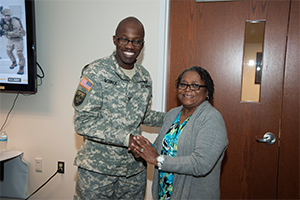Soldier Tours ATC After Receiving Life-Saving Helmet
Louise C. Spangler
Chief, Protective Equipment Division, Firepower Directorate
SSgt. Lewis says he will give the life-saving helmet to his mother, Mrs. Cynthia Boggan, here being greeted by ATC Commander Col. Morris Bodrick.
Machinegun fire impacts a Soldier’s helmet, causing a mere abrasion. Soldier gets closure by receiving the protective equipment that saved his life.
On October 4, 2012, while assigned to 41st Engineer Company, 1st Engineer Battalion, Forward Operating Base Airborne Afghanistan, Staff Sgt. Thalamus Lewis received sustained machinegun fire while on a dismounted route clearance patrol. A single bullet struck him on his Advanced Combat Helmet (ACH), and Lewis sustained forehead abrasions about 1 inch above his right eye.
Lewis’ personal protective equipment (PPE) was retrieved by the Operation Enduring Freedom (OEF) PPE Battle Damage Collection Team. Analysis showed two partial penetrations: one on the left side of the ACH and one on the front center edge.
The wounded Soldier never thought he’d again see the helmet that saved his life. “I was hoping for it, and as the years went on, it got quiet; and then all of the sudden I got an email out of the blue and I was like, ‘Yes, of course I’d like it back,’ and they started the process to get me and my family up here.”
“Here” was Aberdeen Test Center. Lewis visited ATC on April 20, for a Program Executive Office Soldier (PEO Soldier) Warrior Recognition Event. In a ceremony at Fort Belvoir on April 19, Brig. Gen. Brian P. Cummings, PEO Soldier’s program executive officer, presented Lewis with the plaque-mounted helmet that saved Lewis’ life during OEF. The event was part of the Protective Equipment Return Award Program, which began in 2013 in response to Soldier requests for return of life-saving equipment. “It is closure,” said Col. Dean M. Hoffman IV, Soldier Protection and Individual Equipment project manager. “It’s healing for that Soldier to see the piece of equipment that saved his life.”
Before the presentation, PEO Soldier held a Media Round Table on development, production and fielding of Soldier PPE. Panel member Charles D. Valz, director, Firepower Directorate, ATC, commented that annually, ATC tests more than 700 lots of PPE, equating to more than 9,000 subtests, approximately 71,000 rounds fired and nearly one million pieces of body armor fielded. Valz described the ceremony as “a testament to the one goal for all involved with the research, design, testing and acquisition of personal protective equipment—saving Soldier’s lives.”
Lewis and his family, and his Platoon Leader and his wife, Capt. and Mrs. Dillon, were escorted through the Army Research Laboratory (ARL), and then ATC, where Lewis’ helmet was developed and tested. They saw various helmet research efforts, including a project initiated by the National Football League to create helmets providing better protection for football players and Soldiers.
At ATC’s Light Armor Range Complex (LARC), the group received an overview of body armor testing. On display were a helmet similar to that of Lewis’ and an ACH with Gen II helmet sensor, which in theater gathers blast overpressure and acceleration data that is downloaded at wireless checkpoints for head and brain injury research.
Col. Morris Bodrick, ATC Commander, presented Lewis with a framed photo montage from his time at LARC. Lewis and the other visitors each received an ATC Coin. Col. Bodrick closed with words of appreciation for Lewis’ service and dedication.
Lewis is stationed with the Headquarters Battalion and 3rd Infantry Division Headquarters at Fort Stewart, Georgia. After more than 19 years in the Army, he plans to retire this summer. And the helmet? “My Mom’s going to keep it,” he said with a laugh. “She’s already told me.”
You are now leaving www.atc.army.mil and entering another site. You will automatically be forwarded to the target page within five seconds.

